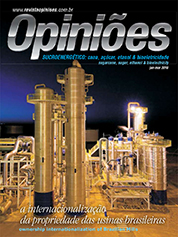Plinio Mário Nastari
President of Datagro
Op-AA-23
Internationalization gained momentum in 2009
In 2005, the theme at Datagro’s international conference, held each year in October, was the internationalization of the production and use of ethanol. We had predicted that ethanol was definitively entering the universe of liquid fuels, leaving behind the perception that it was just an exotic initiative, peculiar to Brazil and the USA.
Growing interest in clean and renewable fuels would lead not only to the expansion of its use to beyond traditional borders, but arouse international interest in the control of production assets, an interest that, at the end of the process, would include the world’s main energy companies. In the past three to four years, we were left with the impression that this process developed at a slower pace compared to what was considered possible or probable.
It was the price crisis of 2007 and 2008 and the liquidity crisis beginning in August 2008 that fully impacted Brazilian industry until the first half of 2009, acting as catalysts of the process of internationalizing control of Brazilian industry. This process is quantifiable based on surveys conducted by Datagro on the volume of sugarcane processed for industrial applications by foreignowned companies.
In 2008, this percentage figure was 12.4%. In 2009, it had increased to 18.4%, and, in 2010, until February, with the Cosan/Shell association, the percentage had leaped to 22.9%. This is significant. Considering that in the 2009/10 harvest 590 million tons were processed in Brazil, this means that about 135 million of the tons processed are already under the control of foreign capital.
Thailand, the second largest sugar exporter after Brazil, is expected to process approximately 70 million tons in the 09/10 harvest. Thus, foreign control in Brazil is practically equivalent to twice the entire production of Thailand. It is important to understand why this is happening. First, the entry of foreign capital would not occur had government intervention not fallen to a level considered minimal.
From a scenario in which the government would set production and distribution quotas, along with the prices of sugarcane and of the end products sugar and ethanol, Brazil developed to a practically totally free system. The exception is the government’s capacity to change the anhydrous ethanol/gasoline mixture, in the range from 20% to 25%, and to set the gasoline price in the re-fineries, which usually does not follow the international price.
The second element that justifies foreign investment is the existence of a dynamic domestic market, which creates important local demand, while supporting the maintenance and development of equally important capital goods manufacturers and the services industry. The third element is the perspective of expanding export markets, not only of sugar, but also of ethanol.
A probable fourth relevant element is the perception that Brazil has an industry that, although already viewed as competitive, is still not optimal, being faced with a huge challenge to reduce costs in the future by making economic use of bagasse and sugarcane straw. Finally, there is the awareness that the diversification process, which began 35 years ago with the more intensive production of ethanol, may develop significantly in the direction not only of co-generation or ethanol from pulp, but also towards the transformation of saccharose.
Thus, there is no lack of reasons for the internationalization of asset ownership to progress at a fast pace. Among the five largest producer groups, four nowadays are foreign-controlled or have foreign participation. The presence of energy companies, which began with British Petroleum’s investment in the production of ethanol, has now definitively been reinforced by the Cosan/Shell association. Certainly others will follow. This shows that ethanol, a pioneer initiative of Brazil, which has been tested since 1925 and expanded following the conception and creation of the Proálcool Program in 1975, has definitively entered the world of liquid fuels.




